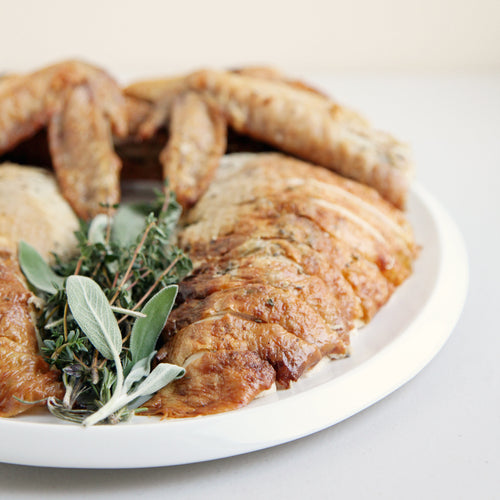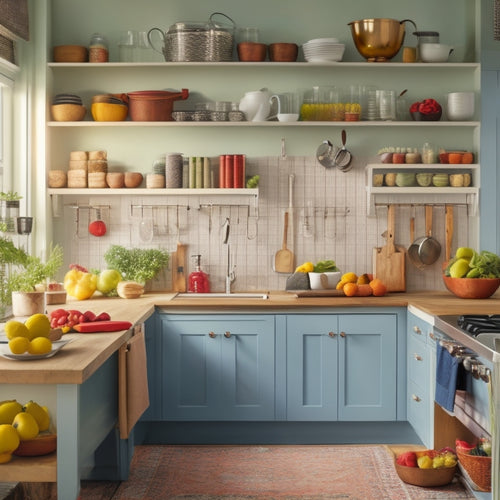
Mastering Kitchen Storage: Proven Strategies Revealed
Share
You're tired of wasting time searching for misplaced kitchen items, and frustrated with the cluttered countertops and disorganized cabinets that hinder your cooking efficiency. To take back control, start by maximizing your cabinet space with drawer dividers, vertical storage, and a "zone" system. Declutter countertops by categorizing items and designating zones, and optimize shelf allocation by storing heavy items at the bottom and frequently used items at eye level. Corner storage solutions, utensil organization, and a maintenance routine will further streamline your kitchen workflow. Now, get ready to uncover more secrets to a clutter-free kitchen that sparks joy and efficiency.
Key Takeaways
• Maximize cabinet space efficiency by installing drawer dividers, utilizing vertical storage, and implementing a 'zone' system for specific items.
• Declutter and organize kitchen countertops by clearing surfaces, categorizing items, and designating zones for each category.
• Optimize shelf allocation by placing heavy items at the bottom, frequently used items at eye level, and less frequently used items on top shelves.
• Transform underutilized corners into valuable storage with Lazy Susans, pull-out shelves, and clever storage solutions.
• Establish a maintenance routine, including weekly tidying, labeling system checks, and storage rotation, to maintain a clutter-free kitchen space.
Kitchen Storage Challenges Exposed
You likely face a daily struggle to find a place for everything in your kitchen, from cramped countertops to cluttered cabinets. This chaos can lead to wasted time, increased stress, and a less-than-ideal cooking experience. One of the primary culprits behind this disorganization is poor pantry organization. When your pantry is a mess, it's difficult to find what you need, leading to duplicate purchases and expired items. Effective pantry organization is key to streamlining your kitchen workflow.
Another significant challenge you face is appliance storage. With the constant influx of new gadgets and devices, it's easy for your countertops to become cluttered. This not only creates a visually unappealing space but also hinders your ability to cook efficiently. By implementing clever storage solutions, such as appliance garages or countertop organizers, you can reclaim your kitchen's functionality.
Maximizing Cabinet Space Efficiency
Optimizing cabinet space is essential to maintaining a clutter-free kitchen, as it allows for seamless access to frequently used items and prevents a buildup of unnecessary clutter. By maximizing cabinet space efficiency, you'll be able to store more items in a smaller area, making your kitchen feel more spacious and organized.
To achieve this, consider implementing the following strategies:
| Strategy | Description |
|---|---|
| Install drawer dividers | Separate items within a drawer to prevent clutter and make it easier to find what you need |
| Use vertical storage | Take advantage of ceiling height by installing shelves or storage units that go up, not out |
| Utilize corner space | Install a lazy Susan or a carousel to make the most of the often-wasted space in corners |
| Implement a "zone" system | Designate specific areas of your cabinet space for specific items, such as baking supplies or cooking utensils |
Decluttering Kitchen Countertops Fast
With a well-organized cabinet space in place, it's time to tackle the clutter that's likely accumulated on your kitchen countertops, where a clutter-free zone can greatly impact your cooking efficiency and overall kitchen experience.
A cluttered countertop can be overwhelming and make cooking a chore. To achieve quick organization, start by clearing everything off your countertops and sorting items into categories - keep, donate, and discard. Be ruthless about getting rid of items that are broken, redundant, or no longer serve a purpose.
Next, designate specific zones for each category of items, such as a coffee station or a baking area. Assign a home for each item, making sure it's easily accessible and frequently used.
Use a 'touch once' rule, where you put items away in their designated spot as soon as you're done using them. By implementing these strategies, you'll be able to eliminate countertop clutter and create a more streamlined kitchen that allows you to focus on cooking and enjoying your meals.
With a decluttered countertop, you'll experience a significant boost in productivity and a more enjoyable cooking experience.
Organizing Kitchen Utensils Effectively
Now that your countertops are decluttered and organized, focusing on the kitchen utensils that are likely scattered throughout your kitchen is essential, and creating a system that keeps them tidy and within easy reach. You'll want to categorize your utensils into groups, such as baking, cooking, and serving tools. This will help you determine the best storage solutions for each group.
Here's a sample organization plan:
| Utensil Group | Storage Solution | Location |
|---|---|---|
| Baking Tools | Drawer dividers | Top drawer |
| Cooking Utensils | Hanging hooks | Near cooking station |
| Serving Utensils | Tray near serving area | Near dining table |
| Specialty Tools | Small storage bin | Near specialty cooking area |
| Infrequently Used | Storage bin on high shelf | Out of the way |
Optimal Shelf Allocation Strategies
You'll need to evaluate your shelf space and allocate it strategically to maximize storage capacity and accessibility. This is essential in achieving best shelf organization and space utilization in your kitchen. By doing so, you'll be able to store more items while maintaining easy access to them.
Here are three key considerations to keep in mind when allocating your shelf space:
-
Heavy items at the bottom: Place your heaviest items, such as pots and pans, at the lower shelves to prevent them from falling and to make them easier to access.
-
Frequently used items at eye level: Store your most frequently used items, like plates and bowls, at eye level to reduce straining and make them easily accessible.
-
Less frequently used items at the top: Reserve your upper shelves for items you don't use as often, such as special occasion dishes or infrequently used cookbooks.
Corner Kitchen Storage Solutions
Corners, often the most underutilized spaces in the kitchen, can be transformed into valuable storage areas with the right solutions. You can maximize the potential of these areas by incorporating clever storage solutions that make the most of the available space.
One effective way to do this is by installing a Lazy Susan in your corner cabinet. This rotating shelf allows you to easily access items that would otherwise be hidden from view, making it a game-changer for corner storage.
Another option is to install pull-out shelves, which can be customized to fit your specific needs. These shelves can be designed to hold everything from cookbooks to kitchen gadgets, and can be easily pulled out when you need access to the items stored within.
Streamlining Kitchen Workflow Systems
By optimizing your kitchen's workflow systems, you can trim precious minutes off meal prep times and create a more enjoyable cooking experience. A well-designed workflow system guarantees that every tool, ingredient, and cooking station is within easy reach, reducing the time spent searching for items or walking between stations.
To achieve workflow optimization, focus on the following key areas:
-
Zone-based organization: Divide your kitchen into zones, such as prep, cooking, and cleaning, and allocate specific tools and ingredients to each zone.
-
Storage accessibility: Make sure that frequently used items are stored in easy-to-reach locations, reducing the need for excessive bending or stretching.
-
Countertop workflow: Designate specific areas of your countertops for specific tasks, such as food prep or cooking, to maintain a logical and efficient workflow.
Hidden Storage Opportunities Found
As you assess your kitchen's layout, look beyond the obvious storage spaces to uncover hidden opportunities that can greatly enhance your kitchen's functionality.
One often-overlooked area is the space above your cabinets. Consider installing decorative storage bins or baskets to store infrequently used items, freeing up prime real estate for everyday essentials.
Another hidden gem is the area beneath your kitchen island or Peninsula. Installing a slide-out drawer or shelving unit can provide additional storage for cookbooks, kitchen gadgets, or even a built-in trash can.
Don't forget to optimize your pantry organization by utilizing adjustable shelves, baskets, and bins to maximize vertical storage. This will keep food and ingredients organized, making meal prep a breeze.
Additionally, take advantage of under sink storage by installing a slide-out drawer or pedestal to store cleaning supplies, sponges, and other essentials, keeping them out of sight but still easily accessible.
Implementing a Maintenance Plan
With your kitchen's hidden storage opportunities now optimized, you're ready to secure your space remains clutter-free and functional over time by establishing a regular maintenance routine. This is essential to guaranteeing that your newly organized kitchen doesn't fall back into chaos. By implementing a maintenance plan, you'll be able to enjoy the benefits of your hard work for months to come.
Here are three essential tasks to include in your maintenance plan:
-
Weekly tidy: Set aside 15 minutes each week to quickly neaten up your kitchen, putting away any items that are out of place.
-
Labeling system check: Quarterly, review your labeling system to make sure it's still working effectively and make any necessary adjustments.
-
Storage rotation: Every 6 months, rotate the contents of your storage containers to make sure that the items you use least frequently are still accessible and not forgotten.
Frequently Asked Questions
Can I Use Adhesive Hooks on Newly Painted Kitchen Walls?
You can use adhesive hooks on newly painted kitchen walls, but exercise proper care to avoid damaging the paint; guarantee wall protection by applying the hooks gently and following the manufacturer's instructions to avoid peeling or scratching.
How Do I Store Kitchen Items That Are Irregularly Shaped?
"You thought storing irregularly shaped kitchen items was a lost cause, but think again! You'll be amazed at how drawer organizers and hanging baskets can tame the chaos, keeping your kitchen tidy and functional."
What Is the Ideal Shelf Depth for Kitchen Storage?
When designing your pantry organization, you'll want to contemplate shelving options with depths between 12-18 inches to maximize cabinet space, allowing easy access to items while keeping them organized and within reach.
Are Over-The-Sink Cutting Boards Worth the Investment?
You're wondering if over-the-sink cutting boards are worth the investment. They offer space-saving solutions and functional design, allowing you to prep meals efficiently while maximizing counter space, making them a valuable addition to your kitchen.
Can I Repurpose Old Furniture for Kitchen Storage Purposes?
You can breathe new life into old furniture by repurposing it for kitchen storage, adopting creative solutions through upcycling furniture, and discovering hidden potential in items like vintage dressers or reclaimed wood shelves.
Related Posts
-

Turkey recipe for thanksgiving
Are you ready to cook a turkey for thanksgiving? We found this recipe of an Easy Herb-Roasted Thanksgiving Turkey tha...
-

5 Best Kitchen Organization Templates With Shopping Lists
You're looking to transform your kitchen into a culinary haven with the help of organization templates and shopping l...

